Metrohm 914pHr User Manual
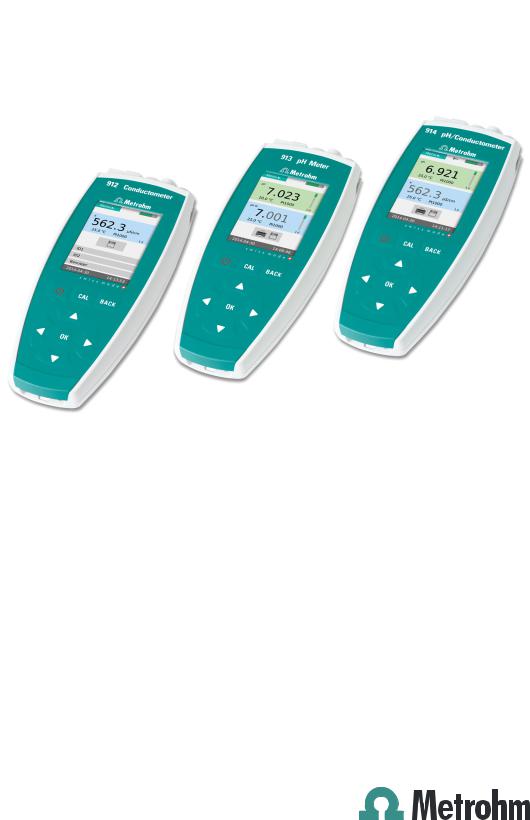
pH Meter/Conductometer
912 Conductometer | 913 pH Meter | 914 pH/Conductometer
Manual
8.912.8001EN / 2014-06-30

Metrohm AG CH-9100 Herisau Switzerland
Phone +41 71 353 85 85 Fax +41 71 353 89 01 info@metrohm.com www.metrohm.com
pH Meter/Conductometer
912 Conductometer | 913 pH Meter |
914 pH/Conductometer
Manual
8.912.8001EN / 2014-06-30 |
fpe |
Teachware Metrohm AG CH-9100 Herisau
teachware@metrohm.com
This documentation is protected by copyright. All rights reserved.
Although all the information given in this documentation has been checked with great care, errors cannot be entirely excluded. Should you notice any mistakes please send us your comments using the address given above.
Documentation in additional languages can be found on
http://documents.metrohm.com.
|
Table of contents |
Table of contents
1 Introduction |
1 |
|
1.1 |
Instrument description ......................................................... |
1 |
1.1.1 |
Model and sales versions ......................................................... |
2 |
1.1.2 |
Power supply ........................................................................... |
2 |
1.1.3 |
Interfaces ................................................................................ |
3 |
1.1.4 |
Sensors .................................................................................... |
3 |
1.2 |
Intended use ......................................................................... |
3 |
1.3 |
About the documentation ................................................... |
3 |
1.3.1 |
Symbols and conventions ........................................................ |
3 |
1.4 |
Safety instructions ................................................................ |
4 |
1.4.1 |
General notes on safety ........................................................... |
4 |
1.4.2 |
Electrical safety ........................................................................ |
5 |
1.4.3 |
Flammable solvents and chemicals ........................................... |
6 |
1.4.4 |
Recycling and disposal ............................................................. |
6 |
2 Overview of the instrument |
7 |
|
2.1 |
Instrument connectors ......................................................... |
8 |
2.1.1 |
912 Conductometer ................................................................ |
8 |
2.1.2 |
913 pH Meter .......................................................................... |
8 |
2.1.3 |
914 pH/Conductometer IS ....................................................... |
9 |
2.1.4 |
914 pH/Conductometer ........................................................... |
9 |
2.2 |
Application environment ................................................... |
10 |
2.2.1 |
Laboratory use ....................................................................... |
10 |
2.2.2 |
Mobile application ................................................................. |
11 |
3 Installation |
|
12 |
3.1 |
Unpacking and inspecting the instrument ....................... |
12 |
3.1.1 |
Packaging .............................................................................. |
12 |
3.1.2 |
Checks .................................................................................. |
12 |
3.1.3 |
Scope of application .............................................................. |
12 |
3.2 |
Power supply ...................................................................... |
12 |
3.2.1 |
Charging the battery .............................................................. |
13 |
3.2.2 |
Operation with power supply unit ......................................... |
14 |
3.2.3 |
Operation via USB connector (PC) .......................................... |
15 |
3.3 |
Connecting sensors ............................................................ |
15 |
3.4 |
Connecting a printer .......................................................... |
16 |
3.5 |
Initial configuration ............................................................ |
16 |
3.5.1 |
Setting the Language ............................................................. |
16 |
3.5.2 |
Setting the date and time ...................................................... |
17 |
3.6 |
Installing updates ............................................................... |
19 |
pH Meter/Conductometer |
III |
Table of contents
4 Operation |
|
21 |
4.1 |
Switching the instrument on and off ............................... |
21 |
4.2 |
Displays ............................................................................... |
21 |
4.3 |
Status displays .................................................................... |
24 |
4.3.1 |
Battery status ........................................................................ |
24 |
4.3.2 |
User rights ............................................................................. |
24 |
4.3.3 |
Sensor quality for pH electrodes ............................................ |
25 |
4.4 |
Control keys ........................................................................ |
25 |
4.5 |
Basic operation ................................................................... |
26 |
4.5.1 |
Main dialog with two measuring channels ............................. |
26 |
4.5.2 |
Main dialog with one measuring channel ............................... |
27 |
4.5.3 |
Operation in the main dialog ................................................. |
28 |
4.5.4 |
Menu dialog .......................................................................... |
29 |
4.5.5 |
Editing dialog ........................................................................ |
30 |
4.5.6 |
Selection dialog ..................................................................... |
32 |
4.6 |
Menu structures .................................................................. |
33 |
4.6.1 |
912 Conductometer .............................................................. |
34 |
4.6.2 |
913 pH Meter ........................................................................ |
35 |
4.6.3 |
914 pH/Conductometer IS ..................................................... |
36 |
4.6.4 |
914 pH/Conductometer ......................................................... |
37 |
4.7 |
Menu dialogs ...................................................................... |
38 |
4.7.1 |
Parameters pH/U/T and Parameters pH/U/T IS ........................ |
38 |
4.7.2 |
Parameters Κ/TDS/Sal/ρ/T ...................................................... |
39 |
4.7.3 |
Measured values .................................................................... |
40 |
4.7.4 |
Sensors .................................................................................. |
42 |
4.7.5 |
Report ................................................................................... |
47 |
4.7.6 |
Configuration ........................................................................ |
48 |
4.7.7 |
User ...................................................................................... |
49 |
4.8 |
pH measurement ................................................................ |
50 |
4.8.1 |
pH electrode calibration ......................................................... |
50 |
4.8.2 |
Measurement ........................................................................ |
52 |
4.9 |
Conductivity measurement ................................................ |
53 |
4.9.1 |
Determination of the cell constant (calibration) ...................... |
53 |
4.9.2 |
Measurement ........................................................................ |
54 |
4.10 |
Outputting reports/measured values ................................ |
56 |
4.10.1 |
Printing out ........................................................................... |
56 |
4.10.2 |
PC/LIMS and CSV data transfer .............................................. |
56 |
5 Operation and maintenance |
59 |
|
5.1 |
General notes ...................................................................... |
59 |
5.1.1 |
Care ...................................................................................... |
59 |
5.1.2 Maintenance by Metrohm Service .......................................... |
59 |
|
5.1.3 |
Sensor care ............................................................................ |
59 |
5.2 |
Quality management and qualification with Metrohm . . |
60 |
IV |
pH Meter/Conductometer |
Table of contents
6 Troubleshooting |
61 |
|
6.1 |
General ................................................................................ |
61 |
6.2 |
Problems ............................................................................. |
62 |
6.2.1 |
Troubleshooting .................................................................... |
62 |
6.3 |
Restarting/resetting the instrument ................................. |
64 |
6.3.1 |
Instrument reset .................................................................... |
64 |
6.3.2 Resetting the instrument to factory settings ........................... |
64 |
|
6.4 |
Messages ............................................................................. |
65 |
7 Appendix |
|
66 |
7.1 |
Saved buffer series ............................................................. |
66 |
7.1.1 |
Metrohm ............................................................................... |
67 |
7.1.2 |
NIST (according to DIN standard 19266, 2000) ...................... |
68 |
7.1.3 |
DIN (according to DIN standard 19267, 2012) ....................... |
69 |
7.1.4 |
Fisher .................................................................................... |
70 |
7.1.5 |
Mettler Toledo ....................................................................... |
71 |
7.1.6 |
Merck CertiPUR 20 / Titrisol ................................................... |
72 |
7.1.7 |
Merck CertiPUR 25 ................................................................ |
73 |
7.1.8 |
Beckmann ............................................................................. |
74 |
7.1.9 |
Radiometer ............................................................................ |
75 |
7.1.10 |
Baker ..................................................................................... |
76 |
7.1.11 |
Hamilton DURACAL ............................................................... |
77 |
7.1.12 |
Fluka ..................................................................................... |
78 |
8 |
Technical specifications |
79 |
|
|
8.1 |
Measuring inputs ................................................................ |
79 |
|
8.2 |
Measured value memory ................................................... |
80 |
|
8.3 |
TFT display .......................................................................... |
80 |
|
8.4 |
Interfaces ............................................................................. |
80 |
|
8.5 |
Power supply ...................................................................... |
80 |
|
8.6 |
Charging time ..................................................................... |
81 |
|
8.7 |
Runtime with battery ......................................................... |
81 |
|
8.8 |
Housing specification ......................................................... |
82 |
|
8.9 |
Safety specification ............................................................ |
82 |
|
8.10 |
Electromagnetic compatibility (EMC) ................................ |
82 |
|
8.11 |
Ambient temperature ......................................................... |
83 |
|
8.12 |
Reference conditions .......................................................... |
83 |
|
8.13 |
Dimensions/material ........................................................... |
83 |
9 |
Warranty (guarantee) |
84 |
|
pH Meter/Conductometer |
V |
Table of contents |
|
10 Accessories |
86 |
Glossary |
88 |
Index |
89 |
VI |
pH Meter/Conductometer |
|
Table of figures |
Table of figures |
|
|
Figure 1 |
pH Meter/Conductometer - front ...................................................... |
7 |
Figure 2 |
912 Conductometer - connectors ...................................................... |
8 |
Figure 3 |
913 pH Meter - connectors ............................................................... |
8 |
Figure 4 |
914 pH/Conductometer (digital) - connectors .................................... |
9 |
Figure 5 |
914 pH/Conductometer (analog) - connectors ................................... |
9 |
Figure 6 |
pH Meter/Conductometer in a laboratory setup ............................... |
10 |
Figure 7 |
pH Meter/Conductometer for mobile application ............................. |
11 |
Figure 8 |
USB Y cable ..................................................................................... |
16 |
Figure 9 |
View - main dialog .......................................................................... |
22 |
Figure 10 |
View - menu dialog ......................................................................... |
22 |
Figure 11 |
View - editing dialog ....................................................................... |
23 |
Figure 12 |
View - selection dialog .................................................................... |
23 |
Figure 13 |
Operation - main dialog, two-channel ............................................. |
27 |
Figure 14 |
Operation - main dialog, one-channel ............................................. |
28 |
Figure 15 |
Operation - menu dialog ................................................................. |
30 |
Figure 16 |
Operation - editing dialog ............................................................... |
31 |
Figure 17 |
Operation - selection dialog ............................................................. |
32 |
Figure 18 |
Example of a message ..................................................................... |
65 |
pH Meter/Conductometer |
VII |

|
1 Introduction |
1 Introduction
This manual gives you a comprehensive overview of the installation, function and operation of pH Meter/Conductometer instruments.
NOTE
You can request application descriptions in the form of
Application Notes and Application Bulletins from your
Metrohm representative or download them from
http://www.metrohm.com.
1.1Instrument description
|
pH Meter/Conductometer instruments are designed for use both out- |
|
doors and indoors as well as for stationary use in the laboratory. |
|
The instruments come in four basic versions, which differ in their design |
|
with regard to different measuring channels and respective functions. |
912 Conductometer |
With a measuring channel for measuring the conductivity, the TDS and |
|
the salinity. |
913 pH Meter |
With an analog and a digital measuring channel each for measuring the |
|
pH value, the potential and the temperature. |
914 pH/Conductome- With a digital measuring channel for measuring the pH value, the poten-
ter IS |
tial and the temperature and a measuring channel for measuring the con- |
|
ductivity, the TDS, the salinity and the temperature. |
914 pH/Conductome- With an analog measuring channel for measuring the pH value, the poten-
ter |
tial and the temperature and a measuring channel for measuring the con- |
|
ductivity, the TDS, the salinity and the temperature. |
pH Meter/Conductometer |
1 |

1.1 Instrument description |
|
1.1.1Model and sales versions
pH Meter/Conductometer instruments are available in the following versions:
Table 1 |
Model versions |
|
|
|
|
|
|
2.912.0010 |
912 Conductometer |
Instrument with standard |
|
|
|
|
accessories |
|
|
|
|
2.912.0110 |
912 Conductometer |
Mobile version with acces- |
|
|
|
|
sories case |
|
|
|
|
2.912.0210 |
912 Conductometer |
Laboratory version with |
|
|
|
|
instrument base console |
|
|
|
|
2.913.0010 |
913 pH Meter (digital/analog) |
Instrument with standard |
|
|
|
|
accessories |
|
|
|
|
2.913.0110 |
913 pH Meter (digital/analog) |
Mobile version with acces- |
|
|
|
|
sories case |
|
|
|
|
2.913.0210 |
913 pH Meter (digital/analog) |
Laboratory version with |
|
|
|
|
instrument base console |
|
|
|
|
2.914.0010 |
914 pH/Conductometer (pH digital) |
Instrument with standard |
|
|
|
|
accessories |
|
|
|
|
2.914.0020 |
914 pH/Conductometer (pH analog) |
Instrument with standard |
|
|
|
|
accessories |
|
|
|
|
2.914.0110 |
914 pH/Conductometer (pH digital) |
Mobile version with acces- |
|
|
|
|
sories case |
|
|
|
|
2.914.0120 |
914 pH/Conductometer (pH analog) |
Mobile version with acces- |
|
|
|
|
sories case |
|
|
|
|
2.914.0210 |
914 pH/Conductometer (pH digital) |
Laboratory version with |
|
|
|
|
instrument base console |
|
|
|
|
2.914.0220 |
914 pH/Conductometer (pH analog) |
Laboratory version with |
|
|
|
|
instrument base console |
|
|
|
|
NOTE
The accessories for a given instrument version can be created as a PDF list on the Internet at http://partslists.metrohm.com.
1.1.2Power supply
The instrument is powered either by a built-in battery or, in stationary use, via a power supply unit.
2 |
pH Meter/Conductometer |
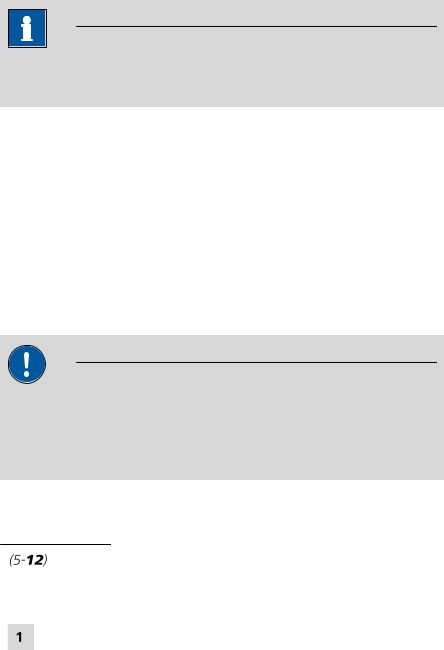
|
1 Introduction |
1.1.3Interfaces
You can connect a printer or establish a connection with a PC for data transfer (PC/LIMS report and CSV format) using the USB interface.
1.1.4Sensors
Metrohm offers various sensors for specific measurements.
NOTE
For more information on the theoretical background, please refer to the
Metrohm monograph Electrodes in Potentiometry.
1.2Intended use
This instrument is suitable for measuring in chemicals and flammable samples. Usage of the pH Meter/Conductometer therefore requires the user to have basic knowledge and experience in handling toxic and caustic substances. Knowledge with respect to the application of the fire prevention measures prescribed for laboratories is also mandatory.
1.3About the documentation
CAUTION
Please read through this documentation carefully before putting the instrument into operation. The documentation contains information and warnings which the user must follow in order to ensure safe operation of the instrument.
1.3.1Symbols and conventions
The following symbols and formatting may appear in this documentation:
|
Cross-reference to figure legend |
|
The first number refers to the figure number, the sec- |
|
ond to the instrument part in the figure. |
|
|
|
Instruction step |
|
Carry out these steps in the sequence shown. |
|
|
Method |
Dialog text, parameter in the software |
|
|
pH Meter/Conductometer |
3 |
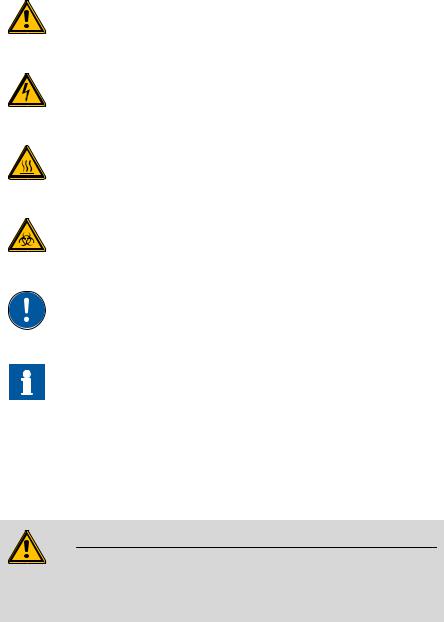
1.4 Safety instructions |
|
|||
|
|
|
||
|
File New |
Menu or menu item |
||
|
|
|
||
|
[Next] |
Button or key |
||
|
|
|
|
|
|
|
|
|
WARNING |
|
|
|
|
This symbol draws attention to a possible life-threat- |
|
|
|
|
ening hazard or risk of injury. |
|
|
|
|
|
|
|
|
|
WARNING |
|
|
|
|
This symbol draws attention to a possible hazard due |
|
|
|
|
to electrical current. |
|
|
|
|
|
|
|
|
|
WARNING |
|
|
|
|
This symbol draws attention to a possible hazard due |
|
|
|
|
to heat or hot instrument parts. |
|
|
|
|
|
|
|
|
|
WARNING |
|
|
|
|
This symbol draws attention to a possible biological |
|
|
|
|
hazard. |
|
|
|
|
|
|
|
|
|
CAUTION |
|
|
|
|
This symbol draws attention to possible damage to |
|
|
|
|
instruments or instrument parts. |
|
|
|
|
|
|
|
|
|
NOTE |
|
|
|
|
|
|
|
|
|
This symbol highlights additional information and |
|
|
|
|
tips. |
|
|
|
|
|
1.4Safety instructions
1.4.1General notes on safety
WARNING
This instrument may only be operated in accordance with the specifications in this documentation.
This instrument has left the factory in a flawless state in terms of technical safety. To maintain this state and ensure non-hazardous operation of the instrument, the following instructions must be observed carefully.
4 |
pH Meter/Conductometer |

|
1 Introduction |
1.4.2Electrical safety
The electrical safety when working with the instrument is ensured as part of the international standard IEC 61010.
WARNING
Only personnel qualified by Metrohm are authorized to carry out service work on electronic components.
WARNING
Never open the housing of the instrument. The instrument could be damaged by this. There is also a risk of serious injury if live components are touched.
There are no parts inside the housing which can be serviced or replaced by the user.
Supply voltage
WARNING
An incorrect mains voltage can damage the instrument.
Only operate this instrument with a mains voltage specified for it (see rear panel of the instrument).
Battery / power supply unit
WARNING
Use the power supply unit only for its intended purpose. Inappropriate use or use of non-approved or incompatible power supply units may cause fires or explosions and result in the revocation of the license or warranty.
If you think that the battery or the power supply unit has been damaged, have it checked by a service center. Do not use damaged batteries or power supply units.
Do not charge your instrument during thunderstorms.
Do not use the power supply unit outdoors.
pH Meter/Conductometer |
5 |
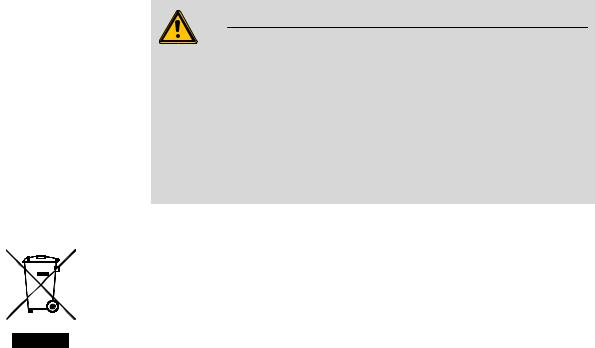
1.4 Safety instructions |
|
1.4.3Flammable solvents and chemicals
WARNING
All relevant safety measures are to be observed when working with flammable solvents and chemicals.
Set up the instrument in a well-ventilated location (e.g. fume cupboard).
Keep all sources of flame far from the workplace.
Clean up spilled liquids and solids immediately.
Follow the safety instructions of the chemical manufacturer.
1.4.4Recycling and disposal
This product is covered by European Directive 2002/96/EC, WEEE – Waste from Electrical and Electronic Equipment.
The correct disposal of your old equipment will help to prevent negative effects on the environment and public health.
More details about the disposal of your old equipment can be obtained from your local authorities, from waste disposal companies or from your local dealer.
6 |
pH Meter/Conductometer |
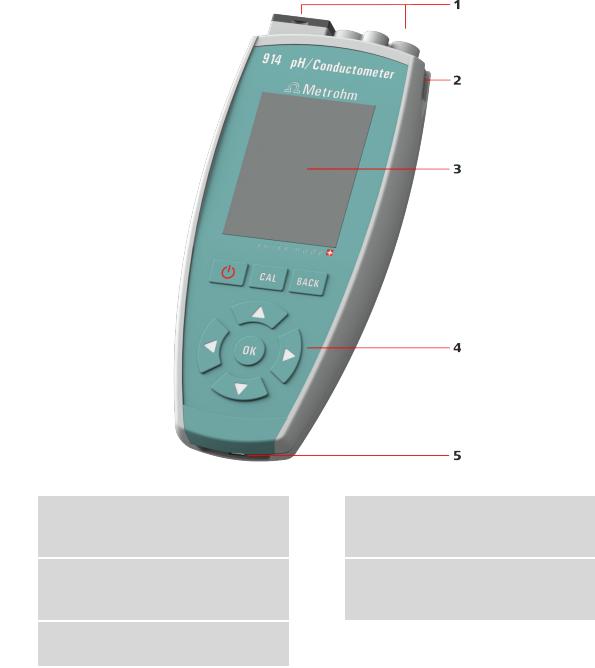
|
2 Overview of the instrument |
2 Overview of the instrument
Figure 1 pH Meter/Conductometer - front
1Connectors / interfaces
With a cover cap for the USB interface and the digital interface.
3Display
For measured values and menus (see Chapter 4.2, page 21).
5Eyelet for carrying strap
As accessory for mobile applications.
2Sensor holder slot
For mobile applications, a sensor holder may be inserted here.
4Keypad
With a total of eight keys to operate the instrument (see Chapter 4.4, page 25).
pH Meter/Conductometer |
7 |

2.1 Instrument connectors |
|
2.1Instrument connectors
2.1.1912 Conductometer
Figure 2 912 Conductometer - connectors
1Conductivity measuring cell
Connection socket for conductivity measuring cells.
2Type B mini USB connector
Connection socket for power supply, data transmission and printing.
2.1.2913 pH Meter
Figure 3 913 pH Meter - connectors
1 |
pH/mV electrode |
|
2 |
Temperature sensor / reference |
|
Connection socket for analog pH/mV elec- |
|
|
|
|
trodes. |
|
|
|
|
|
|
|
|
|
|
|
|
|
3 |
pH/mV electrode |
|
4 |
Type B mini USB connector |
|
Connection socket for 854 iConnect for |
|
|
Connection socket for power supply, data |
|
connecting iTrodes. |
|
|
transmission and printing. |
|
|
|
|
|
8 |
pH Meter/Conductometer |

|
2 Overview of the instrument |
2.1.3914 pH/Conductometer IS
Figure 4 914 pH/Conductometer (digital) - connectors
1 |
Conductivity measuring cell |
|
2 |
pH/mV electrode |
|
Connection socket for conductivity measur- |
|
|
Connection socket for 854 iConnect for |
|
ing cells. |
|
|
connecting iTrodes. |
|
|
|
|
|
3Type B mini USB connector
Connection socket for power supply, data transmission and printing.
2.1.4914 pH/Conductometer
|
Figure 5 914 pH/Conductometer (analog) - connectors |
1 pH/mV electrode |
2 Temperature sensor / reference |
Connection socket for analog pH/mV electrodes.
3Conductivity measuring cell
Connection socket for conductivity measuring cells.
4Type B mini USB connector
Connection socket for power supply, data transmission and printing.
pH Meter/Conductometer |
9 |
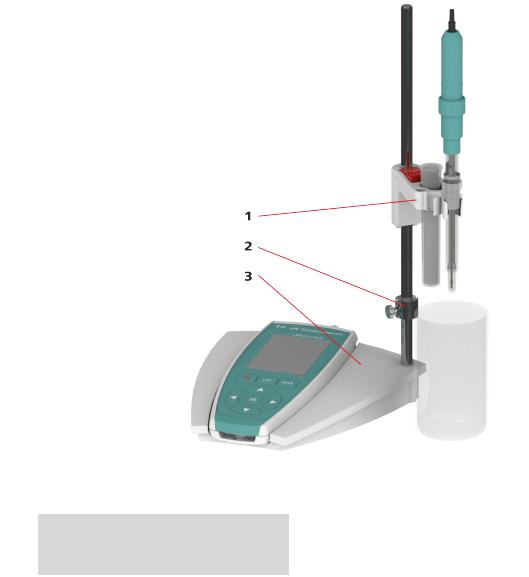
2.2 Application environment |
|
2.2Application environment
pH Meter/Conductometer instruments have been designed for use in laboratories and for mobile use indoors or outdoors.
The sturdy design meets the requirements in accordance with IP 67 protection marking. The instruments are therefore protected against shorttime immersion in water, provided that the respective plugs are plugged in at the sensor connectors.
2.2.1Laboratory use
In the laboratory, pH Meter/Conductometer instruments can be placed in an instrument base console.
Figure 6 pH Meter/Conductometer in a laboratory setup
1 |
Electrode holder |
|
2 |
Clamping ring |
|
|
|
|
|
3Instrument base console
Consisting of receptacle base and support rod.
10 |
pH Meter/Conductometer |
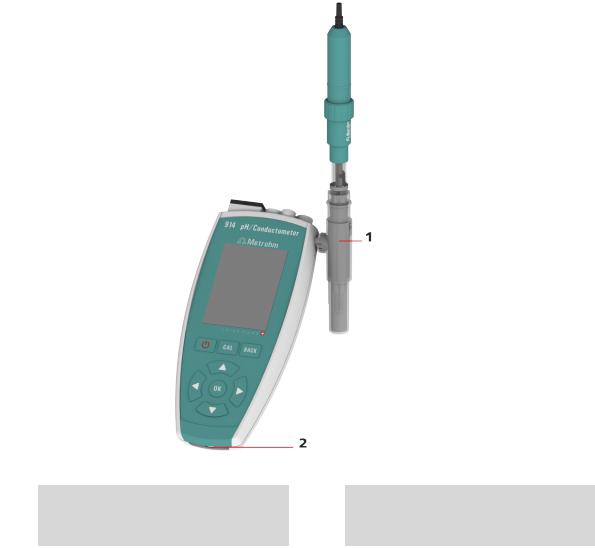
|
2 Overview of the instrument |
2.2.2Mobile application
For mobile application, pH Meter/Conductometer instruments can be equipped with a carrying strap and one or two slide-in holders for electrodes.
Figure 7 pH Meter/Conductometer for mobile application
1 Electrode holder 2 Eyelet for carrying strap
The holders can be inserted from both sides (left/right) of the instrument.
pH Meter/Conductometer |
11 |

3.1 Unpacking and inspecting the instrument |
|
3 Installation
3.1Unpacking and inspecting the instrument
3.1.1Packaging
The instrument is supplied in highly protective special packaging together with the separately packed accessories. Keep this packaging, as only this ensures safe transportation of the instrument.
3.1.2Checks
Immediately after receipt, check whether the shipment has arrived complete and without damage by comparing it with the delivery note.
3.1.3Scope of application
pH Meter/Conductometer instruments have been designed for mobile application outdoors and/or in the laboratory.
CAUTION
Influence of weather conditions
Damage to instruments as a result of sun irradiation or temperatures below the freezing point.
When you do not use the instrument, do not expose it to direct sunlight and to temperatures below 0 °C.
3.2Power supply
The pH Meter/Conductometer is equipped with a built-in battery and can thus be used for mobile applications. For stationary use in the laboratory, the instrument can be operated with a power supply unit.
NOTE
Battery state of charge
You receive the battery in a partially charged state. However, you may have to recharge it again before you can use the instrument for the first time.
12 |
pH Meter/Conductometer |

|
3 Installation |
CAUTION
Unauthorized manipulations
The instrument may be damaged as a result of unauthorized manipulations.
Use for charging only the supplied power supply unit (6.2166.100) or the optional car charger adapter (6.2166.500), which have been approved as accessories for use with this instrument.
Your instrument's battery cannot be removed.
Do not attempt to remove the battery from the instrument. To replace the battery, take the instrument to your nearest authorized Metrohm Service.
Unauthorized replacement of the battery may result in a loss of the warranty.
NOTE
Function of the control keys
For the installation steps below you need to use the control keys.
These are described in the following Operation chapter (see Chapter 4.4, page 25).
3.2.1Charging the battery
NOTE
Charging the battery
The battery is charged only when the instrument is switched on.
Please observe the following procedure:
1.First, connect the USB cable to the supplied power supply unit, then the power supply unit to the socket, and then finally the mini USB connector of the cable to your instrument.
2.Now switch on the instrument using the  key.
key.
3.When the battery is fully charged, disconnect the power supply unit first from the instrument and then from the socket.
or
pH Meter/Conductometer |
13 |

3.2 Power supply |
|
If no power socket is available, you can also charge your instrument via the USB interface of a computer (PC) or a car charger adapter.
NOTE
Charging capacity
The charging process requires a minimum capacity of 500 mAh.
Use a USB hub with external power supply or a suitable USB connector on the computer (PC).
For mobile charging of the battery, use a car charger adapter from the Metrohm accessories (6.2166.500).
1.Connect the USB cable first to the computer and then to your instrument.
2.Then switch on the instrument.
3.As soon as the battery is fully charged, disconnect the USB cable first from the instrument and then from the computer.
NOTE
Battery condition
The battery performance may deteriorate over time. If the operating times are much shorter than usual, take the instrument to the closest Metrohm Service to have the battery replaced.
3.2.2Operation with power supply unit
You can operate the pH Meter/Conductometer with the supplied power supply unit without restrictions.
CAUTION
Measuring with power supply unit connected
Inappropriate power supply units may influence and interfere with the measuring signal.
Use only the supplied power supply unit (6.2166.100) for measuring.
14 |
pH Meter/Conductometer |

|
3 Installation |
NOTE
Charging the battery with power supply
The battery will not be overcharged if the instrument is used for extended periods with the power supply unit connected. The instrument is equipped with a charging controller to protect the battery.
3.2.3Operation via USB connector (PC)
Operation of the instrument with power supply via a USB connector requires a minimum capacity of 500 mAh (see Chapter 3.2.1, page 13).
3.3Connecting sensors
Sensors can be connected while the instrument is running.
NOTE
Parameter setting
Please note that if you change the sensor the sensor has to be selected in the menu dialog Menu Parameters X Measuring parameters Sensor name or a new sensor has to be entered in the sensor list.
NOTE
iConnect for iTrodes
Sensors from the iTrodes line are only supported by the 854 iConnect series 07 or higher.
The series is indicated by the number 17 in the following serial number example:
1854001017216
pH Meter/Conductometer |
15 |
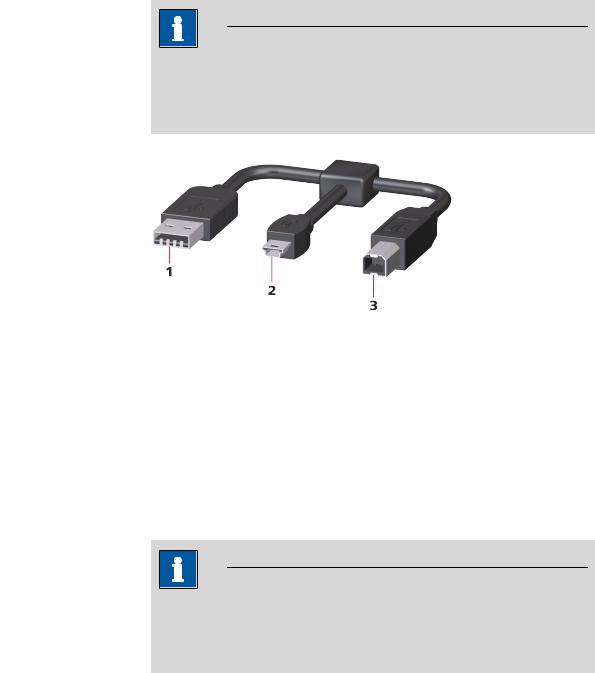
3.4 Connecting a printer |
|
3.4Connecting a printer
Printers for report output are connected with the USB Y cable (6.2151.140).
NOTE
Printer function
The connected printer works only when the
pH Meter/Conductometer is supplied by the power supply unit.
Figure 8 USB Y cable
1 |
USB type A |
|
2 USB type B mini |
|
Power supply unit connector for power sup- |
|
Instrument connector pH Meter/Conduc- |
|
ply. |
|
tometer. |
|
|
|
|
|
|
|
|
3 |
USB type B |
|
|
|
Printer connector. |
|
|
|
|
|
|
3.5Initial configuration
3.5.1Setting the Language
NOTE
"Language" factory setting
On instruments delivered ex works, English is set in the language settings.
The following languages are available on the instrument:
German
English
16 |
pH Meter/Conductometer |

|
3 Installation |
Spanish
French
Portuguese
Chinese
Setting the Language
You can access the menu structures via the Menu item (see Figure 13, page 27) in the main screen.
1 |
Select the entry point with the |
or |
arrow keys. |
|
|
||||
|
|
|
|
|
2 |
Use the |
key to change to the menu structures. |
|
|
|
|
|||
|
|
|||
3Select the Configuration menu structure with the  arrow key and change to the menu structure with the
arrow key and change to the menu structure with the  key.
key.
4Select the Language menu dialog with the  arrow key and change to the selection dialog with the
arrow key and change to the selection dialog with the  key.
key.
5Select the required language with the  or
or  arrow keys and confirm with the
arrow keys and confirm with the  key.
key.
3.5.2Setting the date and time
NOTE
"Date/time" factory setting
The date and time values of the manufacturer are set on the instruments ex works.
In case of deep discharge of the battery, the system time will be reset to the default value.
pH Meter/Conductometer |
17 |

3.5 Initial configuration |
|
Setting the date/time
You can access the menu structures via the Menu item (see Figure 13, page 27) in the main screen.
1 |
Select the entry point with the |
or |
arrow keys. |
|
|
||||
|
|
|
|
|
2 |
Use the |
key to change to the menu structures. |
|
|
|
|
|||
|
|
|||
3Select the Configuration menu structure with the  arrow key and change to the menu structure with the
arrow key and change to the menu structure with the  key.
key.
4Select the Date or the Time menu dialog with the  arrow key and change to the editing dialog with the
arrow key and change to the editing dialog with the  key.
key.
Date format: YYYY-MM-DD
Time format: hh:mm:ss
5 |
|
|
|
Select the required character with the |
, |
, |
, and |
 arrow keys and confirm each with the
arrow keys and confirm each with the  key.
key.
6
Confirm the final value with the editing element and the key.
18 |
pH Meter/Conductometer |

|
3 Installation |
3.6Installing updates
Stay up to date – download the latest versions of the software and programs to your pH Meter/Conductometer to benefit from new and expanded functions. The performance of your instrument may also be improved by software updates.
Downloading the update from the Internet
First, you have to download the data for the instrument update from the
Internet and save it on the computer (PC).
1 Go to http://www.metrohm.com/com/Support/Software.html.
2 Select the instrument in the list box.
3Select the appropriate software version and save it somewhere on your computer.
4Extract the zip file. The two files in the SwUpdates subfolder with the suffixes *.bin and *.mbin will be used for the installation.
NOTE
Data backup
You are recommended to create a backup of the saved data before the update.
Use the Print out or Data transfer functions (see Chapter 4.10, page 56).
Installing the update on the instrument
For the actual installation of the update, the instrument has to be connected to the computer (PC) by means of a USB cable (6.2151.110).
The optional USB Y cable (6.2151.140) cannot be used.
1 Connect the USB cable to the computer and then to the instrument.
2 Switch on the instrument.
pH Meter/Conductometer |
19 |

3.6 Installing updates |
|
NOTE
Switching on the instrument
The USB connection works only when the instrument is on.
The instrument is recognized by the computer (PC) as a removable drive.
3Copy the two files with the suffixes *.bin and *.mbin directly into the root directory of the instrument (removable drive) using a file manager (e.g. Windows Explorer).
4Switch off the instrument after the copy process has been completed and disconnect it from the USB cable.
5Switch on the instrument again and wait for the installation process.
During start-up, the instrument recognizes the new update files and installs these automatically.
20 |
pH Meter/Conductometer |
